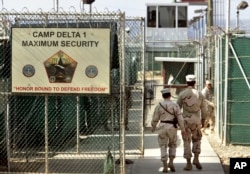The White House says U.S. President Barack Obama plans to transfer abroad more suspected terrorists held at the U.S. detention center at Guantanamo Bay, Cuba, before he leaves office January 20, rebuffing President-elect Donald Trump's call to end such releases.
“There should be no further releases from Gitmo,” Trump said Tuesday, using a nickname for Guantanamo in one of several comments on Twitter he made on a variety of issues. “These are extremely dangerous people and should not be allowed back onto the battlefield.”
Just hours later, however, White House spokesman Josh Earnest said, “I would expect, at this point, additional [prisoner] transfers” before Obama ends eight years as the U.S. chief executive and Trump is sworn in as the country's 45th president.
When Obama took office in January 2009, he vowed to close the prison in southeastern Cuba, saying the detention facility did not reflect American values to the world because many of the prisoners there have been held for years without trial, and some had been tortured.
Detainee population greatly reduced
Guantanamo, a large area in Cuba that has been on long-term lease to the United States since before Fidel Castro's communist revolution, was designated a detention center by former President George W. Bush after the 2001 terrorist attacks that killed nearly 3,000 people in New York and Washington. The camp was intended to house prisoners captured by the U.S. and its allies in the fight against al-Qaida and other terror groups in the Middle East and Afghanistan.
At its peak operation, 779 prisoners were held at Guantanamo; when Bush handed over control of the government to Obama the number had been reduced to about 500 detainees. Obama has subsequently sharply whittled down the number to 59 — returning some detainees to their home countries for prosecution, sending others to third countries for resettlement and releasing others without trial.
However, Obama's stated goal of closing the detention center outright has been been thwarted by a variety of political and legal obstacles. Transferring some or all of the remaining prisoners to secure facilities inside the United States to await trial was considered a possible way to facilitate the camp's closure, but many members of Congress have strongly opposed such tactics.
Evidence flawed by torture
Military prosecutors who would prosecute suspected terrorists detained on faraway battlefields have been stymied because evidence against them was obtained through the use of torture, including waterboarding to simulate drowning — practices that Obama subsequently banned.
About 20 of the remaining prisoners have been cleared for release, but finding other countries willing to accept them has proved difficult. About 30 percent of the onetime Guantanamo detainees have, as Trump suggested, either returned to Middle East battlefields to fight against the U.S. and its allies or are suspected of resuming terrorist activities.
During his lengthy campaign for the U.S. presidency, Trump vowed to keep Guantanamo open, saying at one point that when he became the country's commander in chief, he would “load it up with some bad dudes, believe me. We're gonna load it up.”









